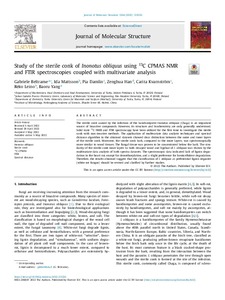Study of the sterile conk of Inonotus obliquus using 13C CPMAS NMR and FTIR spectroscopies coupled with multivariate analysis
Beltrame Gabriele; Mattsson Ida; Damlin Pia; Han Zenghua; Kvarnström Carita; Leino Reko; Yang Baoru
https://urn.fi/URN:NBN:fi-fe2022081153675
Tiivistelmä
The sterile conk caused by the infection of the basidiomycete Inonotus obliquus (Chaga) is an important source of bioactive compounds. However, its structure and biochemistry are only generally understood. Solid state 13C NMR and FTIR spectroscopy have been utilized for the first time to investigate the sterile conk with non-invasive methods. The application of multivariate data analysis techniques and spectral distance algorithm to the obtained datasets showed clear distinction between the outer and inner layers of the sterile conk. Moreover, the sterile conk bark, compared to the inner layers, was spectroscopically more similar to wood tissues. The fungal tissue was proven to be concentrated below the bark. The similarity of the sterile conk inner layers to both decayed wood and hyphae of I. obliquus was shown by the multivariate data analysis of both spectra datasets. The spectroscopic data indicated lack of lignin degradation in the heart rot, except for demethoxylation, and a slight preference for hemicellulose degradation. Therefore, the results obtained suggest that the classification of I. obliquus as preferential lignin degrader (white-rot fungus) should be revised and clarified by further studies.
Kokoelmat
- Rinnakkaistallenteet [27094]
